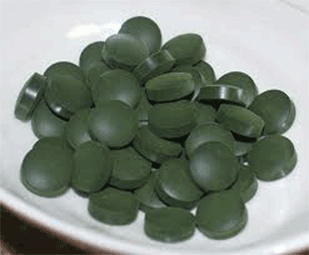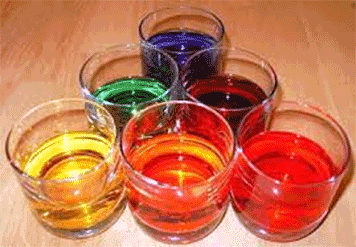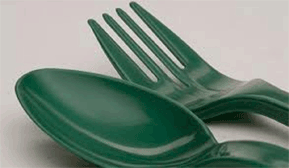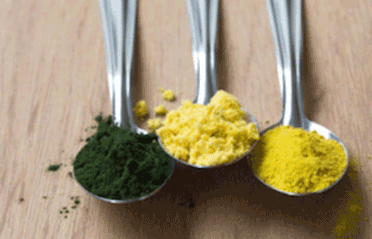
Courtesy of Wiki Commons
There are currently 1000's of people, all over the world, exploring algae products, and trying to build a better world. Here are 23 examples of entrepreneurs using marketing and imagination to algae products to bring to market. For example...
Algae products for human consumption
Most people are surprised to learn of all the algae products available to them on the market already.the most common, and noticeable are food.
Algae use as food has been cited in Chinese literature as early as 2500 years ago. Several parts of Asia are well known for consuming algae (mostly seaweed) directly and some indigenous people in Africa, South America and Mexico consume small quantities of naturally occurring algae mostly because of the vitamins and nutrients they provide.
Microalgae for human nutrition are nowadays marketed in different forms such as tablets, capsules and liquids. They can also be incorporated into pastas, snack foods, candy bars or gums, and beverages, noodles, wine, beverages, breakfast cereals, nutrition bars, cookies.
Algae as a snack

Seaweed: Best known for large scale consumption are the selected species of seaweed that are eaten in Asia. Asia even has a wide variety of seaweed snacks.
My son loves them. :+) Even Costco is getting into the act and selling seaweed snacks. So you know there is money in seaweed snacks.
Algae as a Staple food
Spirulina is the main example of small-scale microalgae cultivation in various parts of the developing world. It also has applications in feed for livestock and aquaculture and as fertilizer, which will be reported on in the relevant sections of this chapter.
Algae Products in the Food Industry
In the food industry, agar is used as a gelatin substitute and is used in the manufacture of creams, sauces, mayonnaise, jellies, custards, puddings, processed cheese and frozen dairy products. It is also used for gelling and thickening in jams and marmalade's and as an anti-drying agent in breads and pastries. Ice creams and other desserts also use agar as a thickener.
Algae Pigments

Pigments found in algae naturally are widely employed as dyes and colorants in the food industry. Natural pigments found in algae species are now used as an alternative to chemical based dyes and coloring agents. A keen interest is shown by the food industry to replace existing chemical coloring agents with algae derived pigments.
Algal pigments are also used as a substitute for chemical dyes and coloring agents in the pharmaceutical, textile and cosmetic industries.
Algae products as Health foods and pharmaceuticals
The market, currently at about 2.5 billion US$, is expected to grow in the future.
The consumption of microalgal biomass as a human health food supplement is currently restricted to only a few species, e.g., Spirulina (Arthospira), Chlorella, Dunalliella, and to a lesser extent, Nostoc and Aphanizomenon.
Algae Animal Feeds

The consumption of microalgal biomass as a human health food supplement is currently restricted to only a few species, e.g., Spirulina (Arthospira), Chlorella, Dunalliella, and to a lesser extent, Nostoc and Aphanizomenon.
The market for microalgal animal feeds, estimated to be about 300 million US$, is quickly growing.
With the increasing demand for food grain production, it is becoming more difficult to spare land for fodder production in the developing countries. However, growing algae products, which can be produced in the homesteads throughout the year without using crop land, may be a help to a certain extent in this situation.
Algae Nutraceuticals

Nutraceutical, a portmanteau of the words “nutrition” and “pharmaceutical”, is a food or food product that reportedly provides health and medical benefits, including the prevention and treatment of disease.
The nutraceutical industry in the US is about $86 billion. This figure is slightly higher in Europe and, in Japan, represents approximately a quarter of the $6 billion total annual food sales. 47% of the Japanese population consume nutraceuticals. Even without specific financial figures, business reports continually suggest that the market is consistently growing.
There are multiple different types of algae products that may fall under the category of nutraceuticals.
• Dietary Supplements
• Functional Foods
• Medical Foods
• Farmaceuticals
Omega-3 Oils
In the most basic sense, algae have three ingredients that make them nourishing to eat:

- chlorophyll and other plant pigments
- omega-3 fatty acids in the form of eicosapentaenoic acid (EPA) and docosahexaenoic acid (DHA)
- important marine minerals such as iodine
Algae are the base of the food chain for fish. Fish consume these algae and then concentrate high amounts of EPA and DHA in their tissues.
The essential fats, or Omega 3's from algae, may improve fatty acid balance and:
- Cardiovascular function
- Nervous system function
- Immunity
- Memory & concentration
- Mood
- Neurotransmission
- Insulin sensitivity & nutrient partitioning
- Body composition
Anti-Oxidants
A number of anti-oxidants, sold for the health food market, have also been produced by microalgae. The most prominent is carotene from Dunaliella salina, which is sold either as an extract or as a whole cell powder ranging in price from 300 to 3,000 US$ per kg. The market size for carotene is estimated to be greater than 280 million US$.
Pharmaceutical Uses of Algae

Algae have a history of being used as herbal medicine to treat sunstroke and intestinal problems in China. The modern pharmaceutical industry also uses algae products.
Medicinal uses of algae date back to ancient times where algae were used to treat ailments like cough, hypertension, diarrhea and gout. Modern research focuses on use of algae as anti-cancer agents.
Antibiotics have been extracted from a wide variety of algae each having a unique chemical action. These compounds have a great scope in the pharmaceutical industry.
A compound called cryptophycin 1 has been identified in blue-green algae which can be used as an anticancer drug and has significant potential. Various species of microalgae produce incredibly potent alkaloids which can be used in cancer treatment.
Algae as coloring Coloring Agents
Cleopatra’s as well as Roman togas were colored with algae coloring agents and pigments. For 1000’s of years various forms of algae have been used as dyes.
Applications

• In Food Coloring: Phycocyanin colorants in general are nontoxic and non-carcinogenic. Uses of phycocyanin in foods include the coloring of fermented milk products, ice creams, chewing gum, soft drinks, alcoholic drinks, desserts, sweet cake decoration, and milk shakes.
•In Clothing: Chlorophyll Derivatives are used for dyeing of fabrics such as wool, acetate derivatives and cotton.
• In Pharmaceuticals: Beta-carotene used in food coloring is a source of Vitamin A.The human body converts betacarotene to vitamin A via body tissues as opposed to the liver, hence avoiding a build up of toxins in the liver. Beta-Carotene has antioxidant qualities.
• In cosmetics: Algal pigments are used for adding exotic colors to soaps. Sea weeds (Macroalgae) are a source of pigments for various hair coloring products due to their long lasting properties.
• In Paint Additives: Diatoms are also used in paint additives, other than algal pigments, due to the iridescent nature of their silica shells.
In Paper Industry: The paper products used generally are not recyclable because of the chemical inks they use. The paper industry is shifting their focus to algae because the inks derived from them are easy to break down and hence easily recyclable.
•In Cancer Research Both phycocyanin and phycoerythrin fluoresce at aparticular wavelength. The light produced by this fluorescence is so distinctive and reliable, that phycobilins may be used as chemical “tags”. The pigments are chemically bonded to antibodies, which are then put into a solution of cells.
Algae Cosmetics

Chemicals with antioxidant properties and vitamins constituents have a whopping scope in the cosmetics, pharmaceutical and food industries.
Lipsticks, nail enamels, body lotions, shaving creams and shampoos all use algae derived products.
Algae products are used in thickening agents, water-binding agents, and antioxidants, as well as in iridescent pigment and packaging for cosmetics.
The use of some microalgal species, especially Arthrospira and Chlorella, is well established in the skin care market and some cosmeticians have even invested in their own microalgal production
Algae Fertilizers
The need for the use of algae bio fertilizers has arisen, primarily for two reasons.
- 1.) Increase in the use of fertilizers leads to increased crop productivity,
- 2.) Increased usage of chemical fertilizer leads to damage in soil texture and raises other environmental problems.
Historically, seaweed has been used as a fertilizer worldwide in coastal regions, mainly for its mineral content and to increase the water-binding capacity of the soil. Microalgal species that fix nitrogen are important, especially in rice cultivation.
After the extraction of oil or carbohydrates from both seaweed and microalgae, most of the nutrients are still present in the left-over biomass. One potential market for this nutrient-rich biomass is as biofertilizer. Market volume is large while the market value is low. In many cases it might be more economic to extract these nutrients for reuse in algae cultivation.
Algae Paper

Courtesy of Wiki Commons
Cellulose-containing algae can potentially be used as a renewable feedstock for paper production as the strong green color of algae is more difficult to bleach than wood fibers but, although algae are generally known for their low cellulose and hemicellulose content, there are a few examples of research into the use of algae as a non-wood fiber source.
Algae Bioconcrete

Algae Bio-Concrete
Algae Bio Plastics
Algae act as an excellent source material for bio-plastic production owing to many advantages such as high product yields and the ability to grow in a range of environments.

Algae serve as a superb feedstock for plastic generation due to its many advantages such as high yield as well as the capacity to expand in a range of environments.
Algae bio plastics mainly produced as a byproduct of algae biofuel manufacturing, where corporations have been discovering different options for income in addition to those from biofuels.
In addition, the use of algae reveals the opportunity of using carbon dioxide, eliminating greenhouse gas pollutants from industrial facilities or power plants.
Algae based plastics have been a recent development in the era of bio plastics in comparison to standard ways of utilizing feed stocks of corn and potatoes as plastics. While algae-based plastics are in their startup phase, the moment they are into commercialization they are likely to discover applications in a great deal of industrial sectors.
Algae Products in aquaculture.
Aquaculture or aqua farming involves the farming of aquatic species such as fish, and aquatic plants. Particular types of aquaculture include fish farming, shrimp farming and alga culture (production of selected strains of algae for commercial use). Fish farming forms the major part of aquaculture.

Marine species which are farmed feed on the algae and grow in large numbers to fulfill food demands. The fish produced as a result of aquaculture are high protein food source.Generally speaking, micro algae are used as feed for the following three classifications
• Mollusks
• Shrimp
• Marine fish
Micro-algae are an essential food source in the rearing of all stages of marine bivalve molluscs (clams, oysters, scallops), the larval stages of some marine gastropods (abalone, conch), larvae of several marine fish species and penaeid shrimp, and zooplankton.
Microalgae are also used as feed in the aquaculture of mollusks, crustaceans (shrimp), and fish. Algae have been used as a component of aquaculture feed stocks for decades, including for fish, abalone, and bivalve mollusk..
There's no question, in today's "green" based culture algae products will play a bigger and bigger role in the future as sustainability becomes more common place. .
Algae Pet Products

The market is big, and booming, and booming especially at the top-dollar end. The American Pet Products Association estimated in 2015 that $58 billion was spent on pets each year. The market has grown 75 percent since 2000,according to Huff Post
Everyone eats algae, they just don't put it directly into their mouths. this is because big fish eat little fish and little fish eat tiny fish and tiny fish eat algae. Because we're at the top of the food chain, we eat the big fish.
Ever wonder why salmon are pink on the inside? Algae. Why flamingos are pink? Algae.
If you are what you eat, which means, you’re made out of algae too.
Don't get out the smelling salts just yet: Nestle and TerraVia are pleased and delighted. Here’s what they had to say.
“TerraVia is a leader in algae nutrition innovation, and at Nestlé Purina we are always seeking out new ingredients to advance pet nutrition to help them live better, more active lives. We are excited about the potential impact these algae-based ingredients can make in the health and the lives of pets,” said Daniel Smith, Vice President of R&D, Nestlé Purina.
Algae Flour

Our friend and buddy Solazyme, has subsequently reached commercial scale at Moema, and bought out Roquette, a global leader in processing plant-based raw materials (corn, wheat, potatoes, peas and microalgae), has introduced a production unit dedicated to microalgae at its industrial site in Lestrem (Pas de Calais, France). The unit has production capacity of 4,000 to 5,000 tons/year.
Here’s the algal flour product line:
•algility HL, whole algal flour, which was recognized as the most innovative ingredient of the year at the FIE Innovation Awards 2013. Roquette said that “this whole food ingredient significantly improves the nutritional qualities of recipes (reduces fat, optimizes lipid profile) while preserving taste and texture.”
• algility HP, whole algal protein. This whole food ingredient, which is under development, combines plant-based proteins (as an alternative to animal proteins), fibers and unsaturated lipids.
• algility chlorella, a nutrient-rich whole food ingredient.
Trust me when I tell you, companies of this size don't invest this kind of money without knowing something the average baker doesn't.
Algae is Vegan!
The vegan diet is gaining popularity the world over and nothing is more vegan than algae. Algae is the original vegan diet. This is something Asia has known for years but is now starting to catch on in the West. Vegan restaurants are popping up everywhere. Certain types of algae can be used as a filler as well as part of the main course. Had sushi lately? The outer wrap is 100% seaweed, aka algae.
You might also be interested in...

25 Algae Products That Can Make You Rich
Here are 25 examples of entrepreneurs using marketing and imagination to algae products to bring to market.. Read More

New Algae Based Products
The number of products currently on the market containing, or using, algae is staggering. There are currently dozens of products and soon there will be hundreds. Read More

The Most Important Life Form You Never Knew Existed
Algae, is the building block of every other life form, even human life.. Read More
The Algae Revolution Has Begun
I learned more from your eBook than spending $6,000...
Dear David,
I have learned more from your e-book than spending $6,000 going to the Algae World 2009 Conference in Rotterdam. Do you have the same manual for Jatropha? Many thanks,
Thanks in advance
Perpetual Prosperty Pumps, Africa



